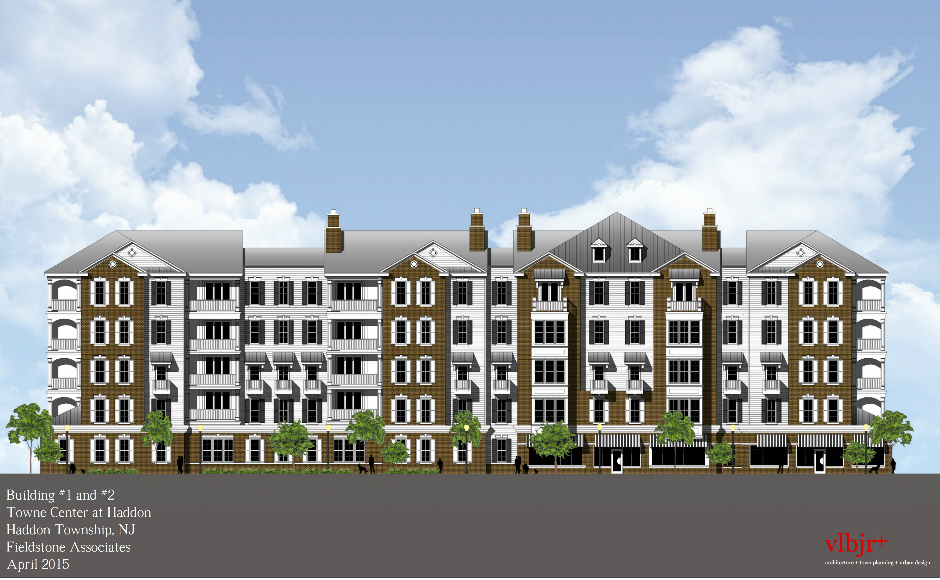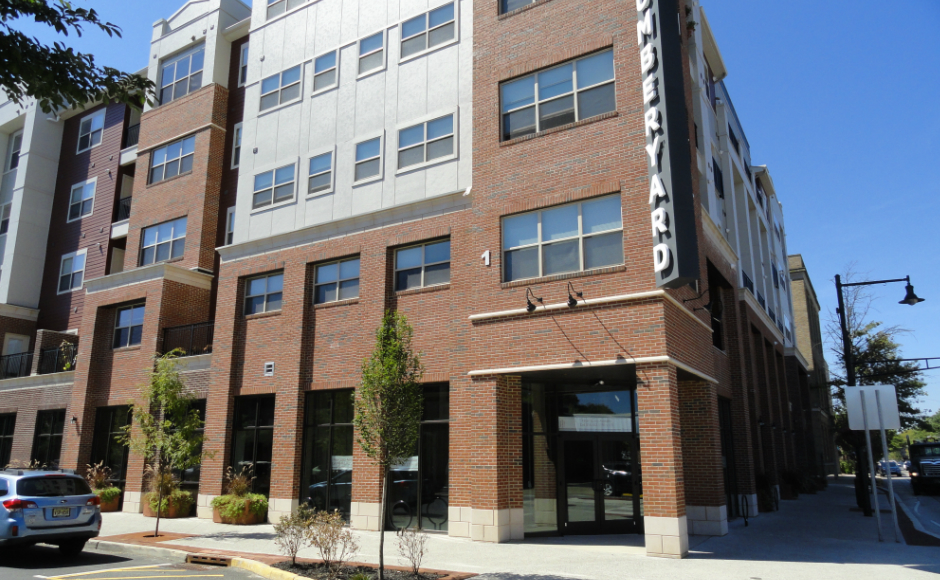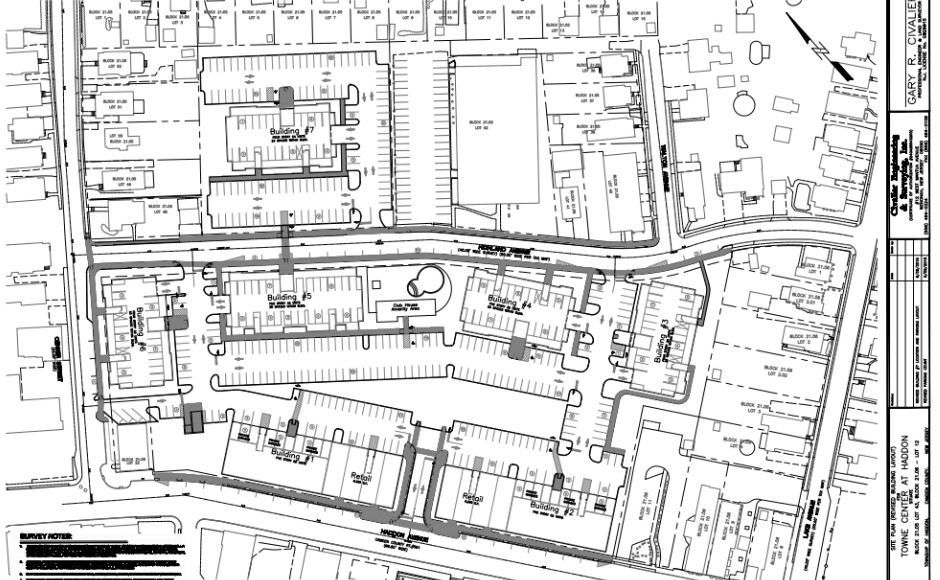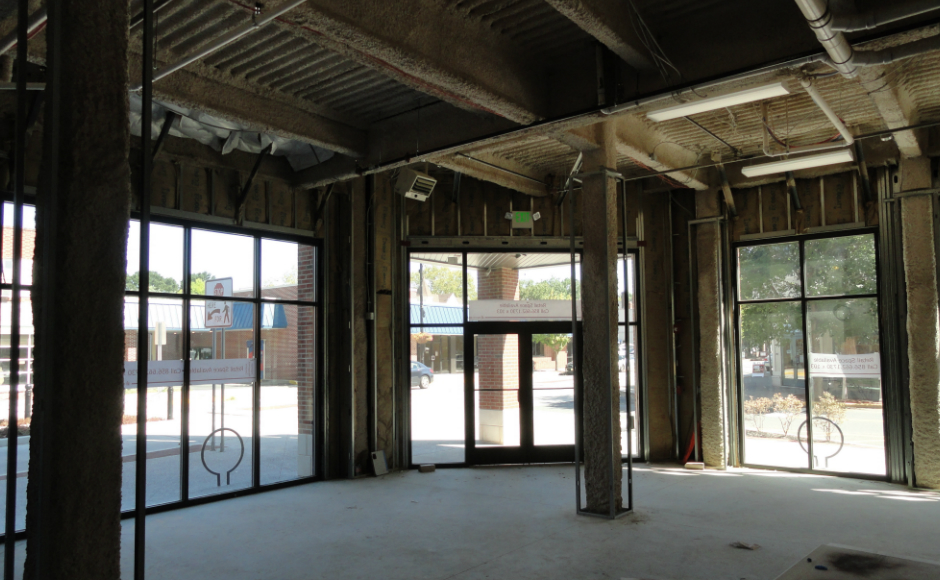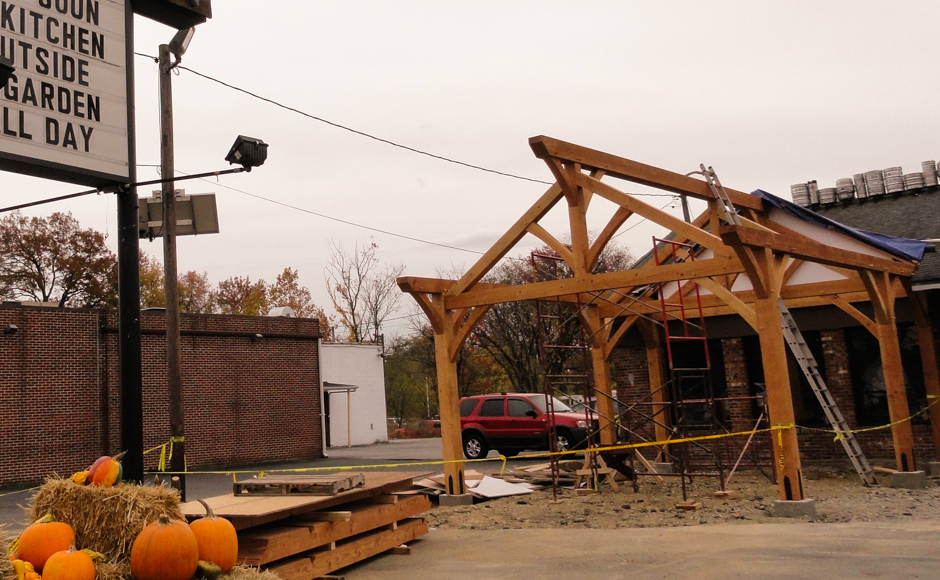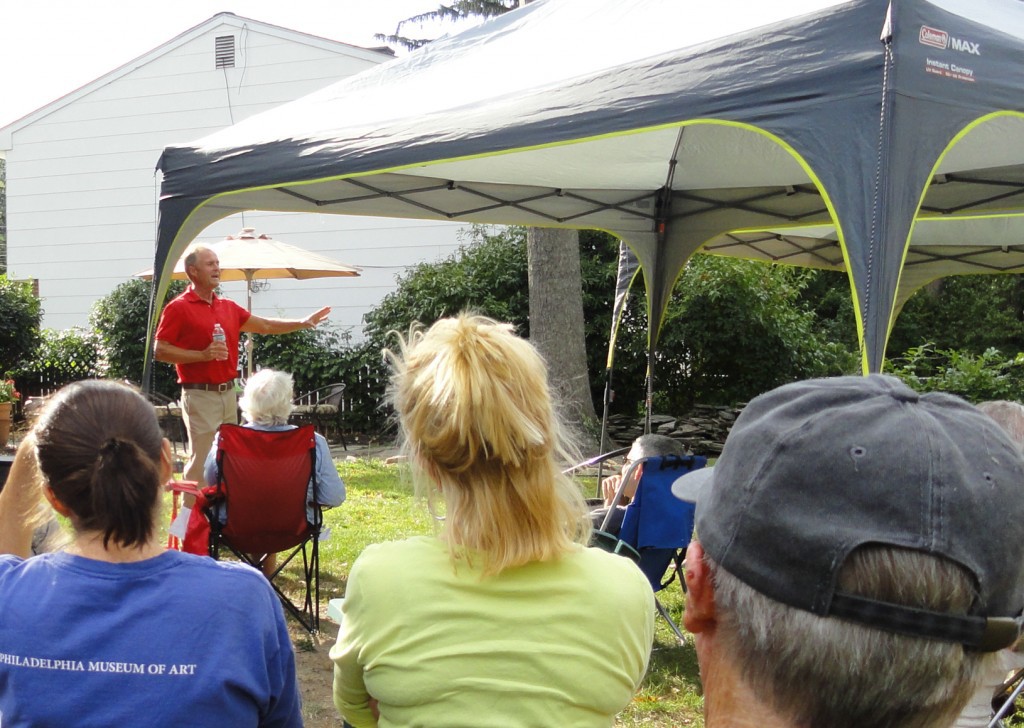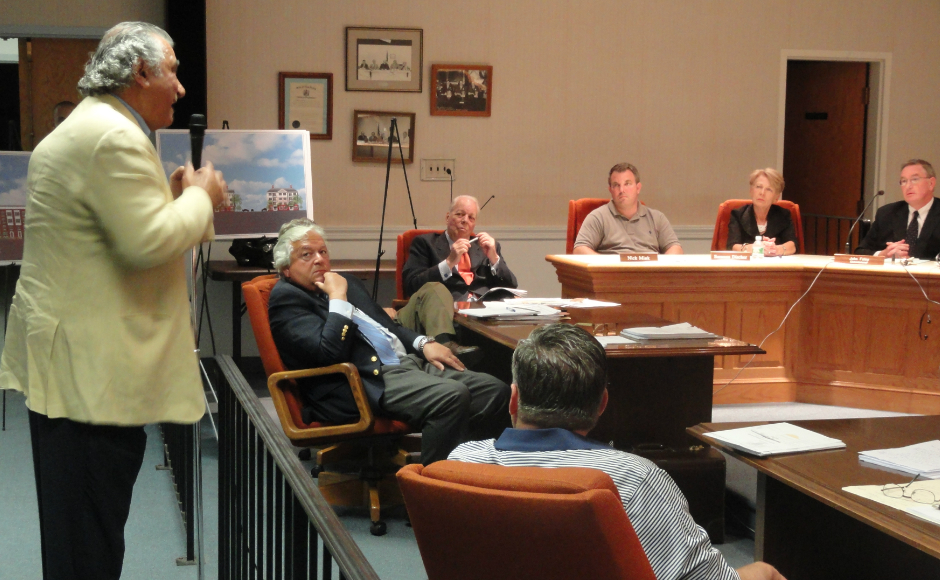Haddon Township will provide a final review of the Dy-Dee site plan in October. But is there still time for residents to participate meaningfully in the process?
By Matt Skoufalos
When developer Brad Ingerman signed onto the Collings at the Lumberyard project, he was entering a very loud, long-running, and public conversation that had dragged the borough of Collingswood into a relative national spotlight over a stalled development project in the heart of the small community.
The public-private redevelopment of the apartment-condo build-out at the former Peter Lumber site along Haddon Avenue had floundered under Costanza Builders, and torpedoed the borough’s credit rating with Moody’s Investor Service when it did.
Although Collingswood did not have to answer questions of affordable housing onsite, the borough was facing financial scrutiny, scrambling to find buyers for unsold units at the property and looking for a development partner to complete the project at the tail end of a collapsed housing market.
Business owners who’d bought into the first-floor properties of the Phase I buildings along Powell Lane complained about the mound of dirt that greeted them instead of customers. A cadre of citizens took the local government to court over the final plan to grant Ingerman a 25-year PILOT agreement, seeking the right to a public referendum on it (they lost the case).
It helped that Ingerman put his money where his mouth is, relocating his 40-employee business as the ground-floor, anchor tenant at the Lumberyard, but none of the various factors with which the developer was contending prevented the project from coming online with smart-growth and transit-forward design principles in play.
“Most of that we got from the planning board,” Ingerman said. “It really was an iterative process between us and the town powers to be, not so much [with]the prospective residents.”
Even though the developer didn’t spend a significant amount of time speaking with would-be tenants because the project was in bail-out mode when he signed on, the Collings at the LumberYard includes several transit-oriented design elements: a 1.1-parking-space-to-unit ratio, a space for a car-sharing service, an onsite public parking garage to support commercial parking, and access to the town-wide Bike Share program across Atlantic Avenue.
“We believed that the location spoke for itself, meaning that we were really in the heart of Collingswood, we were a couple of blocks from transit, and we believed that if we built a great product that they would come,” Ingerman said.
“I know we’re damned close to 100-percent occupied, and people are paying very strong rents,” he said, “so I guess I haven’t bothered asking whether they like it.”
Contrary to conventional wisdom, Ingerman also said The Lumberyard isn’t a millennials-only facility or one that exclusively caters to commuter residents. Demographically, he said, his tenants break down fairly evenly among 25-35-year-olds, 35-45-year-olds, 45-55-year-olds, and those 55 and older. An estimated one-quarter of the 140 residents in the building commute to a job in Philadelphia.
“If you had asked me what would the typical profile be of a resident, I would [have told] you 90% would be between 25-35, and that proved to be totally incorrect,” Ingerman said. “[We rent to] way more people over 45 than I would have thought.”
Ingerman also said that the market-rates units at the Lumberyard command a price that allowed him greater financial flexibility in finalizing the contemporary appearance of his building as well as stocking it with features that are attractive to tenants. Adding more units in a building project at higher rents effectively increases the overall quality of the build, he said.
“Once you get up to 200, 300 units, then the scale is obviously enough to pretty much give almost any amenity that any other place would have,” Ingerman said. “You can spend a lot more for the façade, for the community features, for the outdoor features, for the parking.”
Because Ingerman’s headquarters occupies the bulk of the first floor in the five-story Collings at the Lumberyard building, there is only one 1,500-square-foot commercial space available in the final structure. There were a few false starts in occupying it since the property opened last fall, but the realtor believes he has finally found the ideal tenant for the space, having signed up microbrewer Anthony Abate and his fledgling Devil’s Creek Brewery.
At no point did Ingerman raise the argument that the financials of the project would preclude him from adding first-floor commercial tenants to the building, or that business interest in the town was flagging because other vacant storefronts exist along Haddon Avenue in Collingswood.
Back to the drawing board
One of the few people to propose an alternative vision for the Dy-Dee site based on the latest plans provided by Fieldstone Associates is Collingswood resident Joseph Russell.
A computer scientist with an interest in urban planning, Russell is neither a Haddon Township native nor a policy professional; just a well-read student of civics with a critical eye. He regards urban planning as “a little bit of a rule set” that is not unlike the complex analytical tasks he tackles in his day-to-day experience.
“You’ve got a street, and there’s an intelligent way to put parcels on it,” Russell said. “It’s also [discovering]how do you get the most economic benefit out of it.”
Russell identified a few key alterations for the Fieldstone site plan, and submitted them in a six-page proposal to the Haddon Township government. Some could be more easily achieved than others, he said, like accommodations for bikes and the addition of a space or two for car-sharing services, simply because many people who would choose to live in a transit-oriented building already have planned to reduce their reliance on cars.
“Households that choose to live near public transportation because one or more adult in the family uses that transportation to commute to and from work use their cars less than those who drive to their jobs,” Russell said. “This is the case in my family; we live a half-mile from PATCO and use it daily to get to our jobs. The one car we do have is used very rarely, mostly for weekend trips.”
To that effect, Russell also recommends that the parking requirements at the site should be decreased from 1.8 spaces per unit to around 1 space per unit, limiting the acreage of blacktop that surrounds the facility as well. In the current plan, Building #7 “is surrounded by parking lots, with several banks of parking between it and the street,” Russell wrote in his letter to the township government.
“It is extremely unfriendly to pedestrians to make them walk through parking lots,” he wrote.
Re-orienting the building to the southwestern portion of the block, at the intersection of Highland Avenue and the rear Center Street lots, would keep renters from having to walk through parking lots to get to the sidewalk, Russell said.
Russell is also critical of what he calls “the super-block” in the design plan. Bordered by Haddon, Highland, Lake Avenues and Center Street, the block “impairs the pedestrian experience of Haddon Avenue by creating a monotonous wall of development between East Crystal Lake Avenue and Center Street.
“It also degrades the walkability of the northern lot in which Building #7 sits by forcing residents to walk down Highland Avenue and turning ontoEast Crystal Lake Avenue to walk to the PATCO station,” Russell wrote.
The current layout would most likely instead encourage pedestrians to cut through the empty parking lot to save time, he wrote, adding that parking lots “are among the most pedestrian-unfriendly features of any development, where one has to contend with the unforgiving nature of hot asphalt [and the]lack of a designated and safe pedestrian space, not to mention cars in motion.”
Instead, Russell recommends that the plan include an interstitial street connecting the Haddon-Avenue-facing Buildings #1 and #2 to Highland Avenue.
“This street, with sidewalks installed, will provide a suitable space for pedestrians to walk from building #7 to Haddon Avenue and the PATCO station,” Russell said. “It will also break up the too-long block of Haddon Avenue betweenEast Crystal Lake Avenue and Center Street, improving the immediate streetscape of this stretch of the avenue.”
Where’s the retail?
Russell recognizes that this notion might be the most difficult to achieve of the prospects he’s outlined—unless you count his opinion that the limited retail space on the Haddon-Avenue-facing Buildings #1 and #2, which encompass two separate areas of 6,500 square-feet each, should be expanded.
“You can’t put first-floor residential on such a large, important commercial street as Haddon Avenue,” Russell said. “Dead spots radiate out; you don’t want to make too much of a hole in commercial traffic. I also can’t believe that they would want ground-floor residential right next to Treno.”
As recently as a year ago, Fieldstone contended that the site would be too difficult to construct with any retail space whatsoever; in a special meeting with the planning board, the developer defended its decision to remove commercial space from the building on the grounds that it would obligate additional parking requirements.
At the time, Fieldstone also attempted to justify this decision by claiming that Haddon Avenue already has vacant commercial properties, to which it would be adding more—a line of thinking to which Russell particularly objects.
“The argument isn’t that the beast is some empty storefronts on Haddon Avenue,” he said. “They’re also [effectively]arguing that no one is going to want to open a storefront on Haddon Avenue ever again. That’s ridiculous.
“You’re blocking off that lane for commercial use essentially for decades,” Russell said. “If that’s the point, why are we building something in the downtown if there isn’t commercial pressure? If I’m a business that wants to open on Haddon Avenue because I see a lot of new residents coming in, I’m going to want one of these storefronts.”
Russell points to the beer garden erected farther up the block by Keg & Kitchen, even at the cost of sacrificing a few parking spaces. Cognizent of Albertson Village wrapping up in the rear of the property, Russell said, the bar-restaurant moved ahead with its project, banking on the additional influx of business from its neighbors to the rear.
“There aren’t even people living there yet, and they’re seeing the benefits of that process,” he said.
Russell has submitted his suggestions in writing to all three Haddon Township commissioners; he has no immediate plans to present them to the township planning board in October when Fieldstone makes its final site plan application. But he is nonetheless optimistic that residents can demand greater engagement in the planning process, even if they don’t agree with or ask for any of the provisions he’s identified.
“They still have to give [Fieldstone] final site plan approval,” Russell said. “I feel whatever [residents]need out of the development, they can get. At some point they can’t ask for everything. They can knock off some of those easy things, but I would think [the commissioners]would be open to listening to these suggestions because they asked for them.”
Limited opportunities
Haddon Township Mayor Randy Teague is among the first to point out that the planning process for the Haddon Towne Center project was not begun ideally.
Public input in the project has been hard to come by since its inception, said Teague, who described the process as “sudden.
“There wasn’t any discussions amongst multiple developers,” the mayor said. “It was, ‘Here’s this plan we’re going to do, here’s our developer, we’re voting on it next week.’ That’s how this whole development got started. It didn’t sit well with the community.”
Teague was critical of the agreement that led to the initial redevelopment plan, which he said obligated the township government to pursue the eminent-domain acquisition of 18 private properties within the boundaries of the redevelopment zone. The deal also required that environmental testing and cleanup to be performed at the site before those purchases could be undertaken. Those conditions eventually extended the length of the agreement and exposed the project to unforeseen variables—namely, the economic downturn that befell the housing and lending markets and the implosion of the state Council on Affordable Housing.
“The environmental cleanup and the acquisition of 18 properties put up a big red flag that this was going to take a significant amount of time to accomplish,” Teague said. “Once you build a significant amount of time into a real estate project, you’re subject to risk. The acquisition and the cleanup are not going to be done in six months.”
Because the metrics of the development were limited even before it was challenged by Fair Share Housing and the economic collapse, “a lot of the parameters of the site are already defined, and the numbers are tight,” Teague said.
“We’re giving [Fieldstone] a $6 million PILOT and that’s it,” he said. “There’s not a lot of flexibility. The reason we’re going to 252 units is that’s a number that our financial analysts and Fieldstone agreed upon was necessary to allow them to cover their expenses and make a reasonable profit.”
The mayor also reinforced his view that any additional hesitation before the project gets underway could further affect its viability.
“They may be raising interest rates soon, and that’s going to have a trickle-down effect on this project,” Teague said. “They’ve got to get the bonds done on this or the project’s not doable.”
Despite those strictures, Teague said that both his administration and Fieldstone have been amenable to public comment on the project (although the developer has not responded to repeated requests for comment for this and other stories, either through its attorney or directly). Fieldstone did entertain a meeting with Teague and a small group of citizens who were curious about its mechanics, but as the site plan heads to the township zoning and planning board for review in October, there has been little input from township residents.
Teague also said that he would consider the Transit Village application process as another mechanism to enhance its end result.
“If there’s any ideas that can assist in integrating it to the downtown, obviously we’re open to that,” Teague said. “There are certain parameters that are set, and we can work with those and come up with some ideas that are better than those planned.”
The mayor also pointed to project revisions undertaken by Fieldstone after its proposal to remove the retail component of the project met with disapproval from township residents in 2014.
The redevelopment agreement obliges the developer to continue the streetscape from the Dy-Dee site to the corners that border it along Center Street and Crystal Lake Avenue, but not continuing the project to those corner lots, a byproduct of resistance to the eminent domain zoning, may end up limiting the attractiveness of its commercial spaces to tenants.
“Those are the most desirable,” Teague said. “Starbucks go in the corner spots. That became an issue with the retail because there’s no corners in this retail. But they have to continue the streetscape.”
Teague also warned that the cost of construction is escalating despite presently low federal reserve interest rates; as debt service is more affordable, many towns are able to put jobs out for bid, which means more work for construction companies, who are able to demand better rates. That’s no small consideration even for a community like Haddon Township, which does a significant amount of infrastructure work in-house.
“A few years ago, we were getting some great deals,” Teague. “Now there’s more work out there, so the cost of construction has gone up; however, our carrying costs are minimal because of the low interest rates we’re able to borrow at.”
At some point in the not-too-distant future, the mayor added, Haddon Avenue itself will be up for some significant renovations. The infrastructure atop which the main artery sits “is very old through Collingswood, Haddon Township, and through Haddonfield,” Teague said.
While that may not allow for things like bike lanes to be installed or for a widened street surface, he said, it could provide an opportunity to address streetscaping issues that improve the quality of the pedestrian experience in the future—and to do so with state and federal aid dollars.
“Even as much as the Dy-Dee project is not something that anybody envisioned, it’s still progress,” Teague said. “Instead of an ugly, five-acre, barren site, we’re going to have some development there, and hopefully that will help with the contiguousness of Haddon Township.”
This article is the second of a two-part story exploring planning and design issues around the Haddon Towne Center project. For part one, which explores whether Haddon Township could benefit from a New Jersey Transit Village designation, click here.
Get more local news that matters. Check out NJ Pen on Facebook and Twitter, [tinypass_offer text=”or click here to become a supporter.”]

